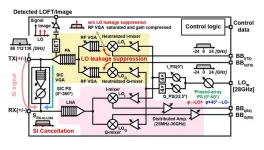(Press-News.org) Millions of people in the US are concussed every year playing sports. Players of games like American football are at particularly high risk for injuries that can have devastating long-term consequences. Stanford University scientists working with the company Savior Brain have now designed one potential way of protecting players: a helmet containing liquid shock absorbers that could reduce the impact of blows to the head by a third.
“Most of the members of our team have a personal connection to traumatic brain injury and we care deeply about ensuring long-term athlete brain health,” said Nicholas Cecchi, a PhD candidate at Stanford University and lead author of the study in Frontiers in Bioengineering and Biotechnology. “Concussion and repeated head impacts are still a major problem in contact sports, and we believe that improved helmet technology can play an important role in reducing the risk of brain injury.”
HARM reduction
Previous research by the Camarillo Lab at Stanford University had suggested that liquid shock absorbers could provide improved protection in sports helmets. To investigate this, the team built a finite element model, used by engineers to simulate performance before manufacturing, of an American football helmet incorporating 21 liquid shock absorbers. This helmet was tested against simulations of the helmet performance evaluation protocol used by the National Football League (NFL), its performance compared to that of four existing helmets. Due to the mounting evidence that the cumulative effect of impacts which don’t cause diagnosed concussions can also have serious health consequences, the team added lower velocity impacts to the evaluation protocol. They measured the head kinematics for each impact to produce a Head Accelerate Response Metric (HARM) score, which is used to evaluate helmet performance under impact. The kinematics were also fed into a model of the head and brain to gauge the resulting strain on the brain.
Reducing impact by 33%
The results showed that the helmet with liquid shock absorbers could dramatically reduce impact severity and strain on the brain caused by head impacts, potentially significantly cutting injuries. The helmet with liquid shock absorbers performed better than the existing helmet models, producing the lowest HARM value in 33 out of 36 different impact conditions tested, with an average reduction in score of a third. The liquid helmet also had the best ‘Helmet Performance Score’, a measure used in the NFL’s annual helmet safety rankings, which includes a weighting for how well a helmet protects against blows in different areas of the head. The highest-weighted location is the ‘side upper’ portion of the helmet because impacts here are most likely to cause concussions: the helmet with liquid shock absorbers reduced the HARM score in this area by 39-50% across all impact velocities without compromising protection in other areas of the helmet.
“The liquid technology offered an average improvement of over 30% for both low and high velocities,” said Dr Yuzhe Liu, corresponding author, who completed the work as a postdoctoral scholar at Stanford University. “It can dramatically reduce the loading on the brain that is experienced during all kinds of American football impacts.”
The team intends to develop the model significantly to protect players better – for instance by incorporating improvements to the facemask and chinstrap. They also plan to develop the model into a physical helmet that could be tested in real-life conditions, and in the future to produce similar helmets for other sports. However, different levels of play or different sports may need assessment by different metrics and design redevelopment.
“The next step for our team is to translate the computer model to a physical prototype,” said Cecchi. “After successfully completing that, we would also be interested in conducting human studies that could demonstrate either a reduction in concussion incidence or an attenuation of impact severity for sub-concussive impacts. We have plans to expand our implementation of liquid shock absorbers to more areas of the helmet, and more helmeted applications, to further improve brain safety for a wide variety of populations.”
END
New high-tech helmets may protect American football players from debilitating concussions
A helmet containing liquid shock absorbers has the potential to reduce the danger of brain injury in contact sports
2023-06-09
ELSE PRESS RELEASES FROM THIS DATE:
Genomic resources to help boost climate resilience of fisheries
2023-06-09
Candidate genes that could help fish to tolerate warmer and saltier water have been identified in new research from the Earlham Institute, potentially providing a vital resource to guide breeding programmes in freshwater aquaculture.
As water quality and availability is reduced by higher global temperatures, these insights can be used to breed more resilient fish and safeguard a key source of food for millions of people.
The Nile tilapia, Oreochromis niloticus, is widely farmed in freshwater aquaculture, providing essential nutrients and protein. Their use in aquaculture has risen dramatically, largely due to their adaptability to different water conditions and ...
New method takes the uncertainty out of oxide semiconductor layering
2023-06-09
Tokyo, Japan – 3D integrated circuits are a key part of improving the efficiency of electronics to meet the considerable demands of consumers. They are constantly being developed, but translating theoretical findings into actual devices is not easy. Now, a new design by a research team from Japan can turn these theories into reality.
In a study recently published for the VLSI Symposium 2023, researchers from Institute of Industrial Science, The University of Tokyo have reported a deposition process for nanosheet oxide semiconductor. The oxide semiconductor resulting from this process has high carrier mobility and reliability in transistors.
3D ...
Preparing the stage for 6G: A fast and compact transceiver for Sub-THz frequencies
2023-06-09
New transceiver design capable of both transmission and reception at frequencies over 100 GHz and at 112 Gb/s data rate could pave the way to 6G technologies, as reported by scientists at Tokyo Tech. By effectively suppressing the self-interference caused by the transmission signal leaking into the receiver, the proposed architecture reaches unprecedented data rates while maintaining a surprisingly compact size.
Scientists and engineers in the field of telecommunications are already working on the technologies that will be used for sixth generation (6G) networks. Ideally, 6G should deliver data rates of ...
Researchers to explore potential of new treatment against vascular dementia
2023-06-09
EL PASO, Texas (June 8, 2023) – Researchers from The University of Texas at El Paso’s School of Pharmacy will explore the viability of a new treatment for vascular dementia, thanks to a $2.2 million grant from the National Institutes of Health (NIH) National Institute of Neurological Disorders and Stroke (NINDS). The grant builds on work that’s previously been done by the team and their collaborators.
Vascular dementia — the second most common type of dementia worldwide — ...
Ancient herbivore’s diet weakened teeth leading to eventual starvation, study suggests
2023-06-09
A team of researchers from the University of Bristol have shed light on the life of the ancient reptile Rhynchosaur, which walked the earth between 250-225 million years ago, before being replaced by the dinosaurs.
Rhynchosaurs are a little-understood group of roughly sheep-sized ancient reptiles that thrived during the Triassic Period, a time of generally warm climates and tough vegetation.
In the new study, the researchers studied specimens found in Devon and used CT scanning to see how the teeth wore down ...
Personalized vaccines may revolutionize cancer treatment
2023-06-09
Researchers from Edith Cowan University (ECU) are leading ground-breaking global trials which could save lives by changing how we treat cancer in the near future.
ECU Centre for Precision Health Clinical Professor Adnan Khattak presented the trial’s latest results at the 2023 American Society of Oncology (ASCO) congress in Chicago this week, the biggest cancer treatment conference in the world with more than 45,000 attendees.
Professor Khattak outlined how survival and disease recurrence rates among people who’d had high-risk skin cancers (melanomas) removed improved significantly when an mRNA vaccine ...
THE LANCET INFECTIOUS DISEASES: Taking a common diabetes medication after testing positive for SARS-CoV-2 reduces risk of developing long COVID by 40%, study finds
2023-06-09
Peer-reviewed / Randomised Controlled Trial / People
Peer-reviewed / Randomised Controlled Trial / People
The Lancet Infectious Diseases: Taking a common diabetes medication after testing positive for SARS-CoV-2 reduces risk of developing long COVID by 40%, study finds
US study of 1,126 overweight and obese people finds 6.3% of participants who took metformin, a medication commonly used to control blood sugar in people with type 2 diabetes, within three days of testing positive for SARS-CoV-2 reported a long COVID diagnosis within 10 months, compared to 10.4% of those who received a placebo.
This is the first published randomised ...
Confidence in vaccines has plummeted in Africa since the pandemic – Study across eight countries shows
2023-06-09
Public confidence in vaccines has plunged across sub-Saharan Africa since the COVID-19 pandemic, according to a study of 17,000 people, across eight countries, published today in the peer-reviewed journal Human Vaccines & Immunotherapeutics.
The findings come as the World Health Organization and UNICEF have reported the largest sustained fall in uptake of routine childhood immunizations in three decades.
Six million fewer children in Africa received routine shots for diseases including tetanus, polio, diphtheria and measles over the past ...
LGB adults at higher risk of suicidal thoughts and self-harm
2023-06-09
Lesbian, gay and bisexual (LGB) people are more than twice as likely than their straight peers to experience suicidal thoughts or self-harming behaviours, finds a new study led by UCL researchers.
The study, published in Social Psychiatry and Psychiatric Epidemiology, is the first ever to analyse nationally representative data on sexual orientation and suicidality in England whilst being able to compare individual sexual minority groups. The researchers analysed data combined from two household surveys of 10,443 English adults (aged 16 and over), representative of the population, sampled in 2007 and 2014.
As ...
University of Arizona launching computer science and engineering B.S.
2023-06-08
Right now, United States employers are unable to fill around 1 million computer science-related jobs because of a lack of qualified candidates, as estimated by the Bureau of Labor Statistics. And the demand isn’t going away – the bureau projects employment in the field to grow much faster than average through 2031, while the number of graduates will continue to lag behind job openings.
This workforce need is the primary reason the College of Engineering will soon offer a bachelor's degree in computer science and engineering, said Michael Wu, head of the Department of Electrical and Computer Engineering, which houses the ...
LAST 30 PRESS RELEASES:
Making lighter work of calculating fluid and heat flow
Normalizing blood sugar can halve heart attack risk
Lowering blood sugar cuts heart attack risk in people with prediabetes
Study links genetic variants to risk of blinding eye disease in premature infants
Non-opioid ‘pain sponge’ therapy halts cartilage degeneration and relieves chronic pain
AI can pick up cultural values by mimicking how kids learn
China’s ecological redlines offer fast track to 30 x 30 global conservation goal
Invisible indoor threats: emerging household contaminants and their growing risks to human health
Adding antibody treatment to chemo boosts outcomes for children with rare cancer
Germline pathogenic variants among women without a history of breast cancer
Tanning beds triple melanoma risk, potentially causing broad DNA damage
Unique bond identified as key to viral infection speed
Indoor tanning makes youthful skin much older on a genetic level
Mouse model sheds new light on the causes and potential solutions to human GI problems linked to muscular dystrophy
The Journal of Nuclear Medicine ahead-of-print tip sheet: December 12, 2025
Smarter tools for peering into the microscopic world
Applications open for funding to conduct research in the Kinsey Institute archives
Global measure underestimates the severity of food insecurity
Child survivors of critical illness are missing out on timely follow up care
Risk-based vs annual breast cancer screening / the WISDOM randomized clinical trial
University of Toronto launches Electric Vehicle Innovation Ontario to accelerate advanced EV technologies and build Canada’s innovation advantage
Early relapse predicts poor outcomes in aggressive blood cancer
American College of Lifestyle Medicine applauds two CMS models aligned with lifestyle medicine practice and reimbursement
Clinical trial finds cannabis use not a barrier to quitting nicotine vaping
Supplemental nutrition assistance program policies and food insecurity
Switching immune cells to “night mode” could limit damage after a heart attack, study suggests
URI-based Global RIghts Project report spotlights continued troubling trends in worldwide inhumane treatment
Neutrophils are less aggressive at night, explaining why nighttime heart attacks cause less damage than daytime events
Menopausal hormone therapy may not pose breast cancer risk for women with BRCA mutations
Mobile health tool may improve quality of life for adolescent and young adult breast cancer survivors
[Press-News.org] New high-tech helmets may protect American football players from debilitating concussionsA helmet containing liquid shock absorbers has the potential to reduce the danger of brain injury in contact sports



